Goal
The goal of the ITSMe (Individual Tree Structural Metrics) R package is to provide easy to use functions to quickly obtain structural metrics from individual tree point clouds and their respective TreeQSMs.
Point cloud based metrics
Overview
An overview of the basic structural metrics which can be measured from an individual tree point cloud with the ITSMe package:
| structural metric | function name |
|---|---|
| diameter at breast height (m) | dbh_pc |
| diameter above buttresses (m) | dab_pc |
| tree height (m) | tree_height_pc |
| projected area (m) | projected_area_pc |
| alpha volume (m) | alpha_volume_pc |
Tree point cloud requirements
The tree point cloud based functions (i.e. those ending with *_pc*) were developed for point clouds acquired with TLS. But they can also be used for tree point clouds obtained from other laser scanning/LiDAR platforms (e.g. MLS, UAV-LS). Keep in mind that the accuracy of the metric measurements will depend on the quality of the data.
Make sure outliers and points that don’t belong to the tree (especially near the trunk) are removed. Good segmentation quality leads to reliable measurements. For instance, if there are outliers floating above of below the tree point cloud, the tree height might be overestimated. If there is a lot of non-tree vegetations still left near the stem, the stem diameter measurement could be affected. If the crown is badly segmented the projected area and alpha volume might be inaccurate.
Down/sub sampling of the point cloud is not required but can reduce computation time for very big tree point clouds (down sampling to 1 to 2 cm is suggested). Down sampling also results in a more homogeneous point density which can be beneficial for calculating metrics such as the stem diameter. Choose your down sampling size also keeping the characteristics (e.g. exit diameter, beam divergence) of your scanner in mind.
Workflow for a single tree
Before running the functions on multiple tree point clouds at a time, it is advised to get familiar with the functions and their input parameters by running the functions on single tree point clouds. Different parameters might be needed for tree point clouds of different quality or trees with different sizes/shapes (e.g. big vs small trees; trees with or without buttresses).
Read the point cloud
All of the point cloud based functions (mentioned above) need a tree
point cloud in the form of a data.frame with columns X, Y, Z as their
first argument. The ITSMe package provides a function
read_tree_pc that takes the path to a tree point
cloud file (txt, ply, las or laz) as an argument and returns a
data.frame with X, Y, Z columns.
# Read the point cloud file from its' specified path
tree_pc <- read_tree_pc(path = "path/to/point/cloud.txt")For making visualisations of big point clouds you can optionally define a samplefactor as an argument as well. This determines the amount of points that are sampled from the point cloud. 1 to sample 100 percent of the points and for example 0.5 to sample 50 percent of the points.
# Read the point cloud file from its' specified path but only sample 10%
tree_pc <- read_tree_pc(path = "path/to/point/cloud.txt", samplefactor = 0.1)Don’t use this samplefactor argument when calculating metrics as this could affect your results.
Measure position of tree point cloud
The position of the tree can be easily determined using
tree_position_pc, which determines the mean X, Y and Z
value of the 100 lowest points of the tree point cloud. Using the 100
lowest points makes it possible to use this function also for UAV-LS
tree point clouds that do not sample the stem very well.
# Measure tree position from the tree point cloud
XYZ_pos <- tree_position_pc(pc = tree_pc)You can optionally use the estimate of the center of the stem diameter circle fit (see later) as the position of the tree.
Measure tree height
The tree height can be measured using tree_height_pc,
which calculates the difference between the Z-value of the highest and
lowest point of the tree point cloud. tree_height_pc only
requires the tree point cloud as an input. It also optionally plots the
tree point cloud in 2D (XZ and YZ plots next to each other) when the
plot parameter equals TRUE.
# Measure tree height from the tree point cloud
H <- tree_height_pc(pc = tree_pc)
# also plot the tree point cloud
H_out <- tree_height_pc(pc = tree_pc, plot = TRUE)
H <- H_out$h
plot_tree <- H_out$plot
However, for tree point clouds that are obtained with for example
UAV-LS (or trees where the stem is obstructed by vegetation) and that do
not sample the base of the tree sufficiently the tree height would be
underestimated. In this case a digital terrain model (DTM) with a
certain resolution can be provided to the tree_height_pc
function to improve tree height estimation. The DTM also needs to be
supplied in the data.frame format with columns X, Y, and Z.
# Read the DTM
DTM <- read_tree_pc(path = "path/to/dtm.txt")
# Measure tree height from the tree point cloud and DTM with resolution r
H <- tree_height_pc(pc = tree_pc, dtm = DTM, r = 1.5)
# also plot the tree point cloud and estimated lowest point based on DTM
H_out <- tree_height_pc(pc = tree_pc, dtm = DTM, r = 1.5, plot = TRUE)
H <- H_out$h
plot_tree <- H_out$plot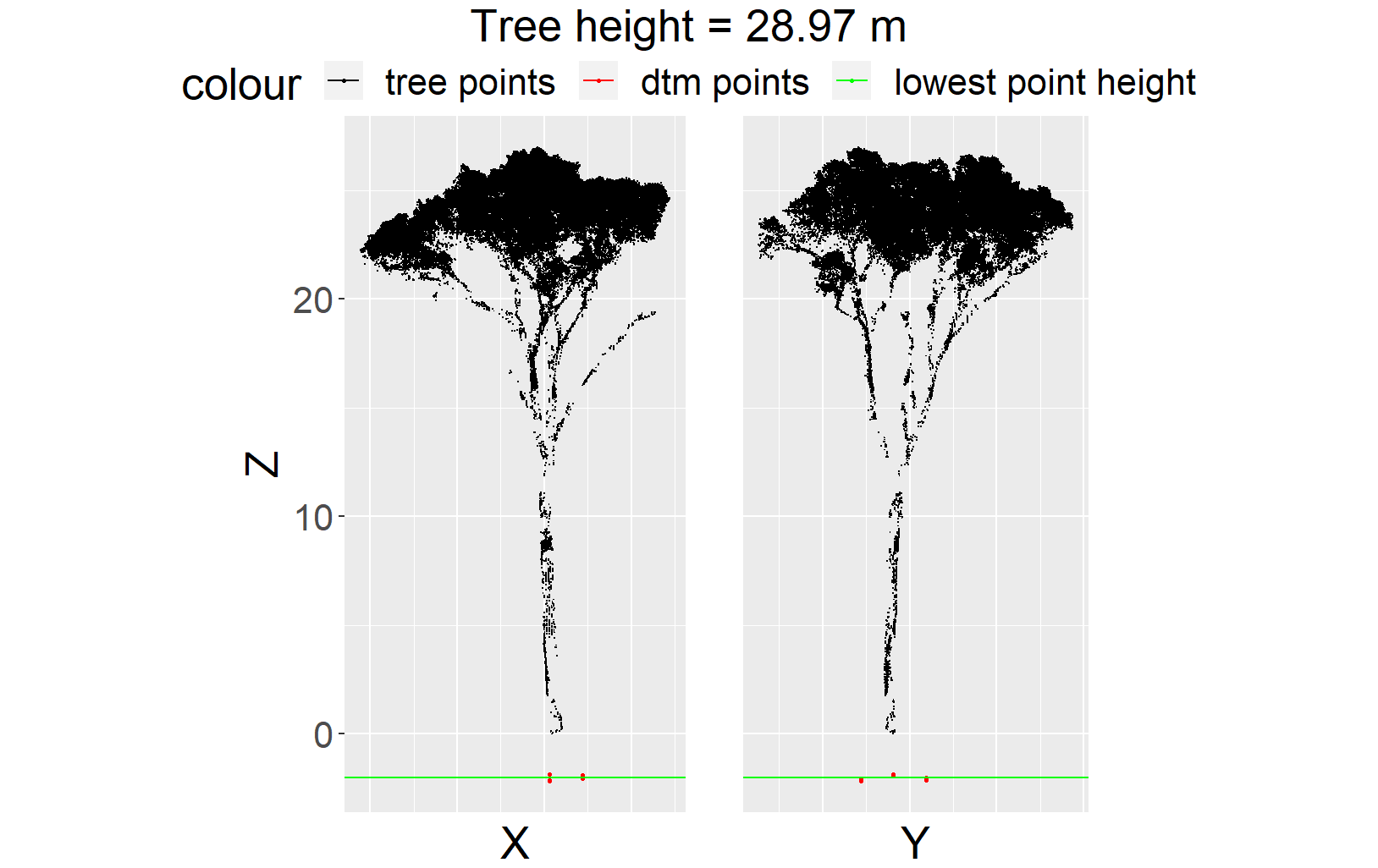
The provided resolution (r) value should be at least the resolution of the provided DTM.
Measure DBH and/or DAB
Depending on if your trees are buttressed or not, you will make a
choice between the diameter at breast height (DBH) and the diameter
above buttresses (DAB). If you are not sure if this is the case for your
tree, you can check the slice (and circle fitting) at 1.3 m with the
diameter_slice_pc function. The diameter is measured as the
circle fit to the slice points. But this function also determines the
functional diameter which is calculated as the diameter of the circle
with the same area as the concave hull fitted to the slice points. This
functional diameter value could be more interesting for trees that
inherently have non-circular stems. But this metric is influenced more
by point cloud and segmentation quality (e.g. noisy points, or
vegetation points which have not been removed from the point cloud, or
incomplete stem point cloud).
# Measure DBH from the tree point cloud and plot the circle fitting
D_out <- diameter_slice_pc(
pc = tree_pc, slice_height = 1.3,
slice_thickness = 0.06, plot = TRUE,
functional = TRUE
)
diameter <- D_out$diameter
functional_diameter <- D_out$fdiameterFor a regular non-buttressed tree:  For a buttressed tree:
For a buttressed tree: 
The DBH is measured using dbh_pc and based on the
diameter_slice_pc function with slice_height of
1.3 m and a chosen slice_thickness (default = 0.06 m). If
branch or vegetation points are present in the slice, the lower (till
1.5 m above lowest point) trunk is extracted (so without
branch/vegetation points) and the fit is done again. The
dbh_pc function needs the tree point cloud as an input. If
the argument plot is set TRUE it also plots the circle fitting.
This function also reports the functional DBH (fDBH) when the argument
functional is set TRUE.
# Measure DBH from the tree point cloud and plot the circle fitting
DBH_out <- dbh_pc(pc = tree_pc, plot = TRUE, functional = TRUE)
DBH <- DBH_out$dbhFor trees without branches at breast height: 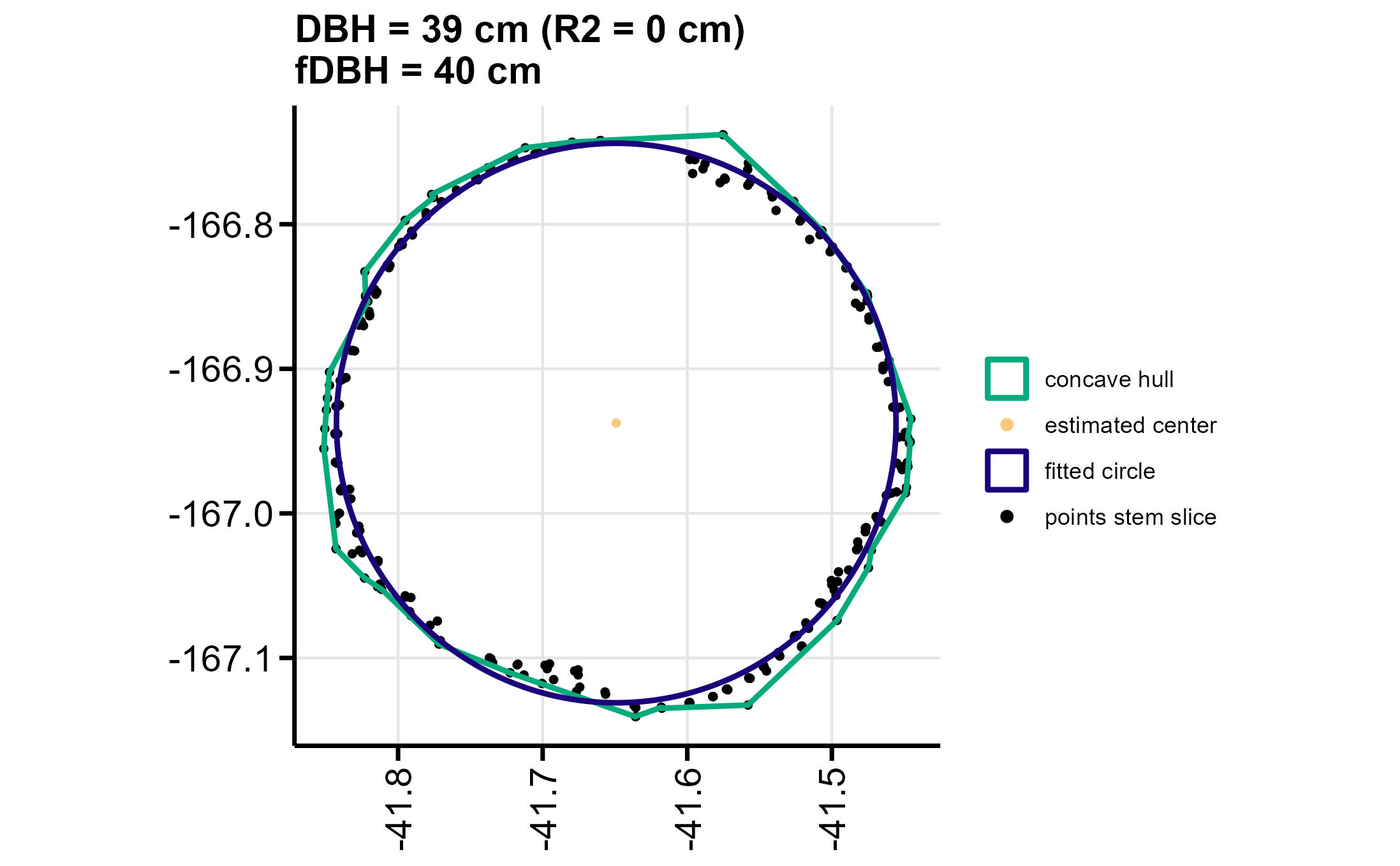 For
trees with branches at breast height:
For
trees with branches at breast height: 
Generally running the dbh_pc with default values is
fine. But there are two other parameters that can be optimised which
influence the trunk extraction. The thresholdR2 parameter
(default = 0.001) determines when the trunk extraction is done. The
trunk is extracted when the initial diameter estimation at breast height
results in NaN, a value higher than 2 m, the residuals are higher than
the thresholdR2 times the estimated diameter or the estimated diameter
is smaller than the diameter estimated at 0.15 m. For trees with
non-circular stems this value should be increased. Also for smaller
trees (DBH < 10 cm) or tree point cloud with a sub-optimal
co-registration of scan positions, for example due to wind a higher
value will lead to better results. The slice_thickness
parameter determines the thickness of the slice at 1.3 m and is default
0.06 m. For tree point clouds with a lower point density at the stem
(e.g. UAV-LS) increasing the slice_thickness to for example 20 cm is
crucial for DBH measurements.
For buttressed trees dbh_pc would result in:
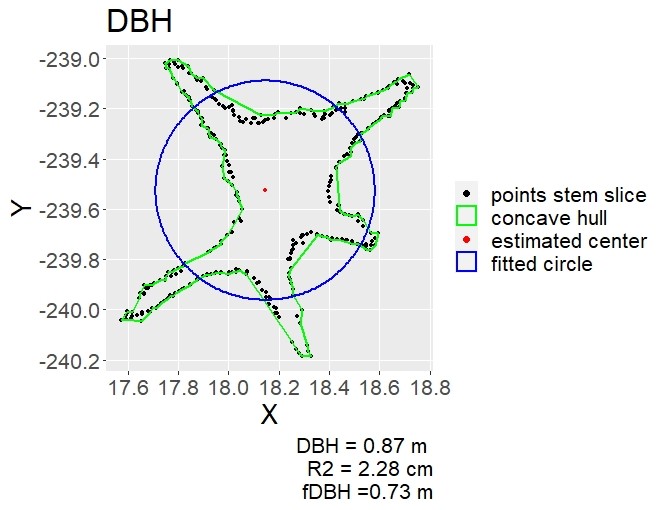
In this case determining the DAB with dab_pc is the
better option. Also for trees with DBH larger than 2 m and no branches
at or below breast height this function is recommended (even if
buttresses are not present). With dab_pc, the diameter
(from the optimal circle fitted through a 6 mm thick horizontal slice)
is measured above the buttresses (if there are no buttresses the
diameter is measured at breast height). The height at which the
horizontal slice is taken (the height above buttresses), is determined
iteratively, starting at breast height. The average residual between the
points and the fitted circle is calculated. When the average residual
exceeds a value of thresholdbuttress times the radius,
indicating a non-circular (irregular) stem shape and presumably
buttresses, and the maxbuttressheight is not exceeded, the
process is repeated with a new slice 6 mm higher than the previous one.
When the maxbuttressheight is exceeded the iterative process is
restarted with a thresholdbuttress increased with 0.0005. Also
in this case a functional DAB (fDAB) is reported.
# Measure DAB from the tree point cloud with default settings and plot the circle fitting
DAB_out <- dab_pc(pc = tree_pc, plot = TRUE, functional = TRUE)
DAB <- DAB_out$dab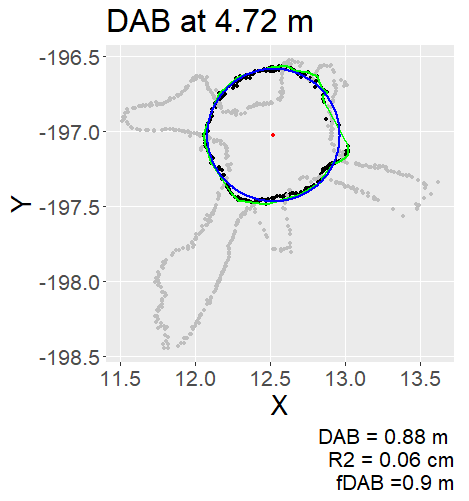
Optimise the values of thresholdbuttress and or maxbuttressheight for your tree if default values do not lead to the desired results:
- reduce/increase thresholdbuttress if the height above buttresses is consistenly too low/high.
- reduce/increase maxbuttressheight if your buttresses reach lower/higher heights.
The dbh_pc and dab_pc functions do not yet
work well on very slanted trees. Therefore it is advised to always check
the plots of the circle fitting. For slanted trees it might be more
accurate to extract the dbh from the treeQSM.
For tree point clouds of which the stem of the tree is not
sufficiently sampled dbh_pc and dab_pc will
not work due to a lack of stem points.
The dbh_pc and dab_pc functions also output
a center value which gives the X and Y coordinate of the center of the
estimated circle fit. This can also be used as a tree position
value.
Classify crown points
As a basis for crown metrics (e.g. projected crown area and 3D alpha
crown volume) the classify_crown_pc is used to return the
points from the tree point cloud that belong to the crown. The crown is
defined here as all points of the tree except for the stem points below
the first branch. The height where the first branch emerges is
iteratively determined (starting from minheight) as the height
where the diameter of the stem exceeds thresholdbranch
multiplied with the DBH or DAB.
# Classify the tree point cloud with default settings and plot the classification results
C_out <- classify_crown_pc(pc = tree_pc, plot = TRUE)
crown_pc <- C_out$crownpoints
plot <- C_out$plot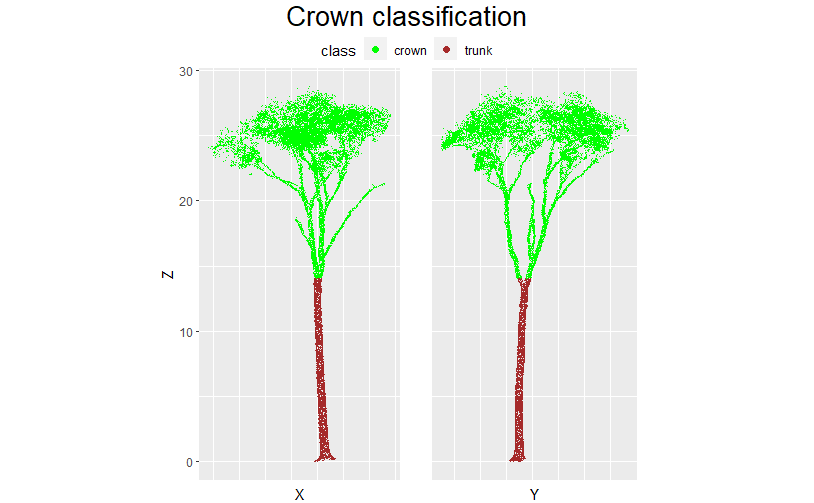
Optimise the values of thresholdbranch and or minheight for your tree if default values do not lead to the desired results:
- reduce/increase thresholdbranch if the crown height is consistently determined too high/low.
- reduce minheight if the height at which the crown starts is typically lower.
- increase minheight to the height above the widest part of the lower stem (for example above the buttresses).
For non-buttressed trees, specify the previously determined thresholdR2 and slice_thickness parameters. For buttressed trees, the attribute buttress has to be set TRUE and previously chosen attributes thresholdbuttress and maxbuttressheight can be specified. It is recommended to increase the minheight for buttressed trees.
# Classify the tree point cloud of a buttressed tree and plot the classification results
C_out <- classify_crown_pc(
pc = tree_pc, minheight = 4, buttress = TRUE,
plot = TRUE
)
crown_pc <- C_out$crownpoints
trunk_pc <- C_out$trunkpoints
plot <- C_out$plot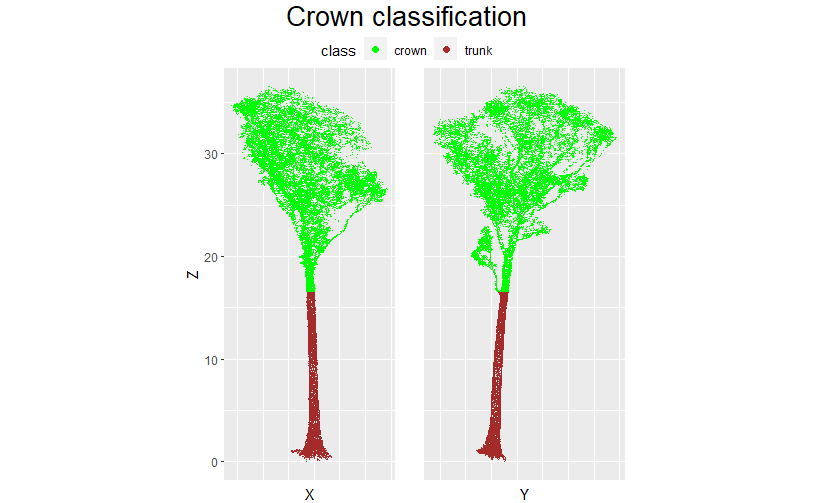
From the crown point clouds and trunk point clouds you can easily determine the metrics including crown height, height of first branch etc.
Measure the projected area
The projected (crown) area of a tree point cloud can be measured with
projected_area_pc which calculates the area of a concave
hull (based on concaveman)
fitted to the input point cloud. The concavity (default=2) can
be chosen and a plot is made when parameter plot equals TRUE.
If the input point cloud is the full tree point cloud the output is the
projected tree area. If the input is the crown point cloud (determined
with classify_crown_pc or in your own way) the output is
the projected crown area.
# Measure the projected crown area and plot the results
out <- projected_area_pc(pc = crown_pc, plot = TRUE)
pca <- out$pa
plot <- out$plot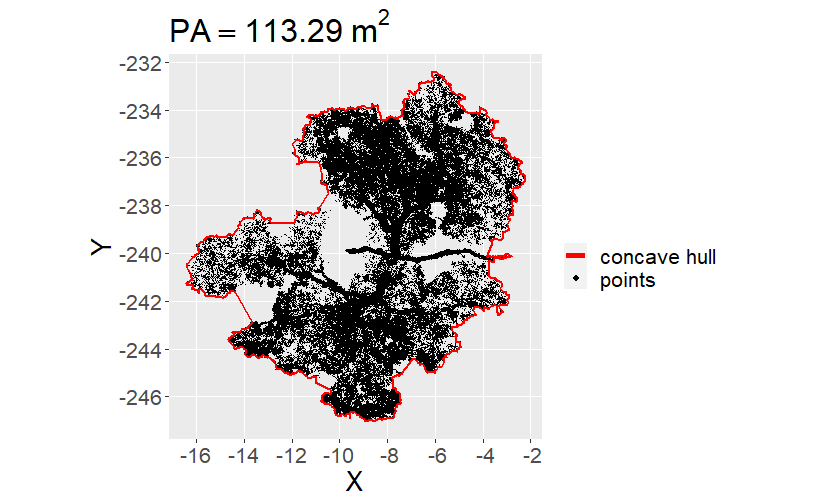
Depending on the tree structure (e.g. not slanted, full crown, etc.) you can also determine the projected crown area from the full tree point cloud.
Measure the 3D alpha volume
The 3D alpha (crown) volume of tree point cloud can be measured with
alpha_volume_pc which calculates the volume of the 3D
alpha-shape (based on alphashape3d)
fitted to the (crown) points. The alpha (default=1) can be
chosen and a 3D plot is made when parameter plot equals
TRUE.
# Measure the crown volume and generate 3D plot
out <- alpha_volume_pc(pc = crown_pc, plot = TRUE)
volume <- out$av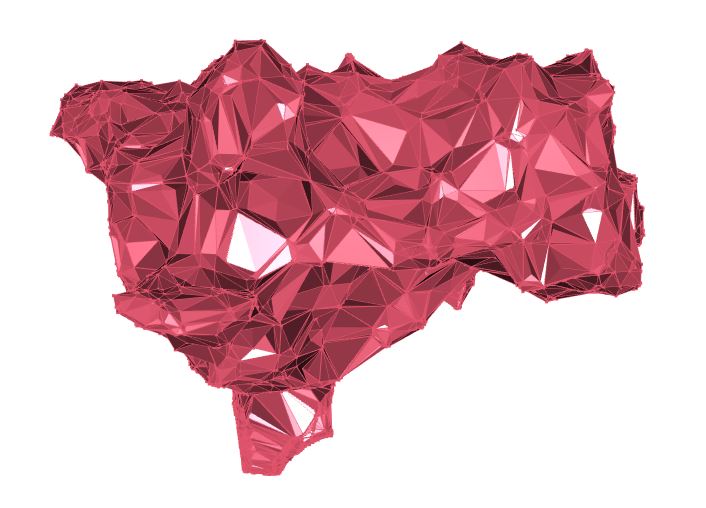
Workflow for multiple trees
Optimise and plot
Often you want to check or optimise the performance of the (default)
attributes used in tree height, DBH, DAB, crown classification,
projected area, and 3D alpha volume calculation, for multiple tree point
clouds in one folder. For this purpose you can use
plot_tree_height_pcs (based on
tree_height_pc), plot_circle_fit_pcs (based on
diameter_slice_pc), plot_dbh_fit_pcs (based on
dbh_pc), plot_dab_fit_pcs (based on
dab_pc), plot_crown_classification_pcs (based
on classify_crown_pc), plot_pa_pcs (based on
projected_area_pc), plot_av_pcs (based on
alpha_volume_pc) which return the tree height, diameter,
DBH, DAB, PCA and CV for each tree in a folder (PCs_path) and
save the respective figures in the given output path
(OUT_path). First run these functions with default parameters
and check the rendered figures. Optionally change the attributes of the
functions:
-
plot_tree_height_pcs: r (when DTM is provided) -
plot_dbh_fit_pcs: thresholdR2, slice_thickness -
plot_dab_fit_pcs: thresholdbuttress, maxbuttressheight -
classify_crown_pc: thresholdbranch, minheight -
plot_pca_pcs&volume_crown_pc: concavity & alpha
# Tree height:
# Plot the tree point clouds (check for outliers)
# Specify dtm and r in case lower part of tree is not sampled
Hs <- plot_tree_height_pcs(
PCs_path = "path/to/point/clouds/folder/",
extension = ".ply",
OUT_path = "path/to/output/folder/",
dtm = DTM, r = 2
)
# DBH:
# try out different thresholdR2 and slice_thickness values when default values fail
DBHs <- plot_dbh_fit_pcs(
PCs_path = "path/to/point/clouds/folder/",
extension = ".ply",
OUT_path = "path/to/output/folder/",
thresholdR2 = 0.0025, slice_thickness = 0.2
)
# DAB:
# try out different values for thresholdbuttress and maxbuttressheight when default values fail
DABs <- plot_dab_fit_pcs(
PCs_path = "path/to/point/clouds/folder/",
extension = ".las",
OUT_path = "path/to/output/folder/",
thresholdbuttress = 0.002, maxbuttressheight = 9
)
# Crown classification:
# For non-buttressed trees: (buttress = FALSE,) specify thresholdR2 and slice_thickness chosen in previous step
# For buttressed trees: buttress = TRUE, specify thresholdbuttress and maxbuttressheight chosen in previous step
# Try out different values for thresholdbranch and minheight
crown_pcs <- plot_crown_classification_pcs(
PCs_path = "path/to/point/clouds/folder/",
extension = ".txt",
OUT_path = "path/to/output/folder/",
thresholdbranch = 2, minheight = 3, buttress = TRUE,
thresholdbuttress = 0.002, maxbuttressheight = 9
)
# Projected area
# Try out a different value for concavity
# indicate crown = TRUE if you want to calculate projected area on the crown points only
# In this case: also specify the values for the crown classification chosen in previous step
PAs <- plot_pa_pcs(
PCs_path = "path/to/point/clouds/folder/",
extension = ".ply",
OUT_path = "path/to/output/folder/", concavity = 3,
thresholdbranch = 2, minheight = 3, buttress = TRUE,
thresholdbuttress = 0.002, maxbuttressheight = 9
)
# 3D alpha volume
# Try out a different value for alpha
# indicate crown = TRUE if you want to calculate projected area on the crown points only
# In this case: also specify the values for the crown classification chosen in previous step
AVs <- plot_av_pcs(
PCs_path = "path/to/point/clouds/folder/",
extension = ".las",
OUT_path = "path/to/output/folder/", alpha = 2,
thresholdbranch = 2, minheight = 3, buttress = TRUE,
thresholdbuttress = 0.002, maxbuttressheight = 9
)Summarise
Once you have decided on default/optimised attributes, you can
summarise all point cloud structural metrics in one data.frame (and
optionally export it to a csv file) for all tree point clouds in a
folder with summary_basic_pointcloud_metrics. If the
plot parameter is TRUE, a summary figure is rendered for each
tree in the folder.
If you find different optimal attribute values for different trees, split the trees up in groups with the same parameter values (e.g. small and big trees, species1 and species2). Put the groups in different folders and run the summary function on the different folders separately. Afterwards the outputs can be combined.
# Summary with default setting for non-buttressed trees and plot the summary
summary <- summary_basic_pointcloud_metrics(PCs_path = "path/to/point/clouds/folder_non-buttressed_trees/")
# Summary with default setting (except minheight and buttress) for buttressed trees
summary <- summary_basic_pointcloud_metrics(
PCs_path = "path/to/point/clouds/folder_buttressed_trees/",
minheight = 4, buttress = TRUE
)
# Summary only with tree height and stem diameter info
summary <- summary_basic_pointcloud_metrics(
PCs_path = "path/to/point/clouds/folder_buttressed_trees/",
metrics = c("stem diameter","tree height")
)
# Summary of all point clouds with "control" in their names
summary <- summary_basic_pointcloud_metrics(
PCs_path = "path/to/point/clouds/folder_buttressed_trees/",
pattern = 'control'
)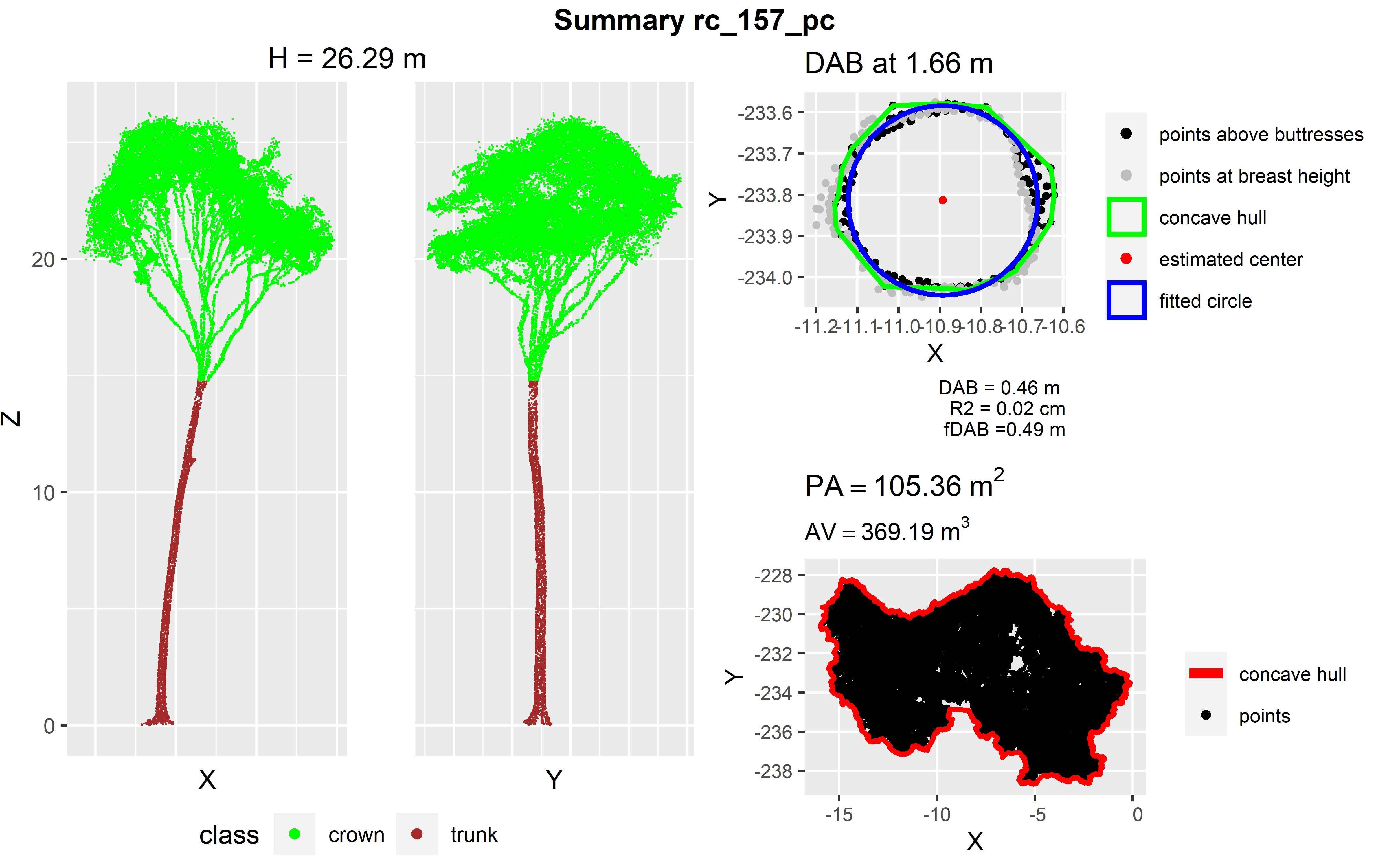
QSM based metrics
Overview
At the moment the ITSMe package contains TreeQSM based structural metrics defined by Åkerblom et al. (2017) and Terryn et al. (2020).
Structural metrics from Terryn et al. (2020)
These are the metrics defined in Terryn et al. (2020) which were copied and adapted from Åkerblom et al. (2017) except for the branch angle ratio and the relative volume ratio which were new metrics. Definitions of the metrics can be found in the help files of the functions and the papers of Terryn et al. (2020) and Åkerblom et al. (2017). Normalisation according to Terryn et al. (2020) as well as Åkerblom et al. (2017) is possible through the normalisation parameter included in the functions of the metrics that were adapted by Terryn et al. (2020). If the tree point cloud is provided along with the TreeQSM in the functions, DBH or DAB and tree height values are based on the point clouds rather than the QSMs. When the buttress parameter is indicated “TRUE” the DAB instead of the DBH is used.
| structural metric | function name | input |
|---|---|---|
| stem branch angle (degrees) | stem_branch_angle_qsm | TreeQSM |
| stem branch cluster size | stem_branch_cluster_size_qsm | TreeQSM |
| stem branch radius (-/m) | stem_branch_radius_qsm | TreeQSM (+point cloud) |
| stem branch length (-/m) | stem_branch_length_qsm | TreeQSM (+point cloud) |
| stem branch distance (-/m) | stem_branch_distance_qsm | TreeQSM (+point cloud) |
| dbh tree height ratio | dbh_height_ratio_qsm | TreeQSM (+point cloud) |
| dbh tree volume ratio (m) | dbh_volume_ratio_qsm | TreeQSM (+point cloud) |
| volume below 55 | volume_below_55_qsm | TreeQSM |
| cylinder length volume ratio (m) | cylinder_length_volume_ratio_qsm | TreeQSM |
| shedding ratio | shedding_ratio_qsm | TreeQSM |
| branch angle ratio | branch_angle_ratio_qsm | TreeQSM |
| relative volume ratio | relative_volume_ratio_qsm | TreeQSM |
| crown start height | crown_start_height_qsm | TreeQSM (+point cloud) |
| crown height | crown_height_qsm | TreeQSM (+point cloud) |
| crown evenness | crown_evenness_qsm | TreeQSM |
| crown diameter crown height ratio | crown_diameterheight_ratio_qsm | TreeQSM (+point cloud) |
| dbh minimum tree radius ratio | dbh_minradius_ratio_qsm | TreeQSM (+point cloud) |
Workflow for a single tree
Read the TreeQSM
All of the TreeQSM based functions (mentioned above) need one or
multiple components (e.g. cylinder, branch, treedata) of a TreeQSM in
the form of lists as their fist arguments. The ITSMe package provides a
function read_tree_qsm which reads a TreeQSM matlab file
(.mat) and returns its’ components in a list (and optionally saves the
TreeQSM components into the global environment when global =
TRUE). It requires the path to the TreeQSM .mat file as a first
argument and the TreeQSM version as a second (default =
“2.4.0”) argument.
# Read the TreeQSM file from its' specified path
qsm <- read_tree_qsm(path = "path/to/treeqsm.mat")
# Read the TreeQSM file of version "2.3.0" from its' specified path into the global environment
qsm <- read_tree_qsm(
path = "path/to/treeqsm.mat", version = "2.3.0",
global = TRUE
)Extract metrics Terryn et al. (2020)
After reading in the TreeQSM, the 17 different structural metrics listed in the table above can easily be calculated. Some of these structural metrics rely on only one of the TreeQSM components.
# Calculate the stem branch angle and branch angle ratio from the branch component
sba <- stem_branch_angle_qsm(branch = qsm$branch)
bar <- branch_angle_ratio_qsm(branch = qsm$branch)
# Calculate stem branch cluster size and crown evenness from the cylinder component
sbcs <- stem_branch_cluster_size_qsm(cylinder = qsm$cylinder)
ce <- crown_evenness_qsm(cylinder = qsm$cylinder)
# Calculate the cylinder length volume ratio from the treedata component
clvr <- cylinder_length_volume_ratio_qsm(treedata = qsm$treedata)Other metrics rely on two of the TreeQSM components.
# Calculate the volume below 55 and the relative volume ratio from
# the cylinder and treedata component
vol_55 <- volume_below_55_qsm(cylinder = qsm$cylinder, treedata = qsm$treedata)
relvol_ratio <- relative_volume_ratio_qsm(
cylinder = qsm$cylinder,
treedata = qsm$treedata
)
# Calculate the shedding ratio from the branch and treedata component
shed_ratio <- shedding_ratio_qsm(branch = qsm$branch, treedata = qsm$treedata)For some of the metrics which involve the DBH/DAB and/or the tree height, the tree point cloud of the tree can be provided as an input besides the TreeQSM data. This is because (in general) the DBH/DAB and tree height are more accurately measured from the complete tree point cloud. When the DBH is involved the DAB will be used if buttress = TRUE. Also specify the attribute values determined for the DBH or DAB measurement from a tree point cloud (see previous sections),
# Read the tree point cloud
tree_pc <- read_tree_pc(path = "path/to/point/cloud.txt")
# Calculate the dbh min tree radius and volume ratio using additional point cloud data
dmrr <- dbh_minradius_ratio_qsm(
treedata = qsm$treedata,
cylinder = qsm$cylinder, pc = tree_pc,
thresholdR2 = 0.0025
)
dvr <- dbh_volume_ratio_qsm(
treedata = qsm$treedata, pc = tree_pc,
slice_thickness = 0.1
)
# Calculate the dbh height ratio of a buttressed tree using additional point cloud data
# Specify the optimised thresholdbuttress and maxbuttressheight when needed
dhr <- dbh_height_ratio_qsm(
treedata = qsm$treedata, pc = tree_pc,
buttress = TRUE, thresholdbuttress = 0.002,
maxbuttressheight = 5
)
# Calculate the crown start height, crown height and crown diameter height ratio
# using additional point cloud data
csh <- crown_start_height_qsm(
treedata = qsm$treedata, cylinder = qsm$cylinder,
pc = tree_pc
)
ch <- crown_height_qsm(
treedata = qsm$treedata, cylinder = qsm$cylinder,
pc = tree_pc
)
cdhr <- crown_diameterheight_ratio_qsm(
treedata = qsm$treedata,
cylinder = qsm$cylinder,
pc = tree_pc
)Normalisation according to Terryn et al. (2020) as well as Åkerblom et al. (2017) is possible through the normalisation parameter included in the functions of the metrics that were adapted by Terryn et al. (2020).
# Calculate the stem branch radius according to Åkerblom et al. (2017)
sbr <- stem_branch_radius_qsm(
cylinder = qsm$cylinder, treedata = qsm$treedata,
normalisation = "parentcylinder"
)
# Calculate the stem branch length according to Terryn et al. (2020)
sbl <- stem_branch_length_qsm(
branch = qsm$branch, treedata = qsm$treedata,
normalisation = "treeheight"
)
# Calculate the stem branch distance according to Åkerblom et al. (2017) and
# using point cloud information
sbd <- stem_branch_distance_qsm(
cylinder = qsm$cylinder,
treedata = qsm$treedata, normalisation = "dbh",
pc = tree_pc, buttress = TRUE,
thresholdbuttress = 0.002,
maxbuttressheight = 5
)Workflow for multiple trees
Summarise metrics Terryn et al. (2020)
you can summarise all structural metrics defined by Terryn et
al. (2020) in one data.frame (and optionally export it to a csv file)
for all TreeQSMs in a folder with summary_qsm_metrics.
Choose the normalisation for stem_branch_radius_qsm,
stem_branch_length_qsm, and
stem_branch_distance_qsm. In case you want to use tree
point cloud information, specify the folder (PCs_path) and
extension of the tree point cloud files, indicate if the trees
have buttresses (buttress) and specify if you want to use
non-default argument values (thresholdR2,
slice_thickness, thresholdbuttress and
maxbuttressheight) to calculate the DAB (see chapter on point
cloud metrics). If you want the data.frame to be exported to a csv file,
specify the path to the output folder (OUT_path).
The QSM files have to be of the format xxx_qsm.mat (xxx is tree id and can consist of multiple parts e.g. plot name, tree number) or xxx_qsm_0.mat (0 at the end is for example the n-th QSM that is made for tree 000). The qsm file can also contain multiple QSMs, in this case set parameter multiple = TRUE. When multiple QSMs are provided for one tree the mean and the standard deviation of the values of the different QSMs of one tree are also returned in additional data.frames. When provided, the tree point clouds files have to be of the format xxx_pc in order to link the tree point cloud to its’ respective treeQSM.
# Run the summary function with default settings (without point cloud info)
summary_qsm_metrics(QSMs_path = "path/to/treeqsm/folder/")
# Run the summary function with multiple QSMs per *mat file
summary_qsm_metrics(QSMs_path = "path/to/treeqsm/folder/", multiple = TRUE)
# Run the summary function with default settings with point cloud info
summary_qsm_metrics(
QSMs_path = "path/to/treeqsms/folder/",
PCs_path = "path/to/point/clouds/folder/"
)
# Run the summary function with non-default settings with point cloud info
summary_qsm_metrics(
QSMs_path = "path/to/treeqsms/folder/", version = "2.4.0",
sbr_normalisation = "parentcylinder",
sbl_normalisation = "dbh", sbd_normalisation = "dbh",
PCs_path = "path/to/point/clouds/folder/",
extension = ".ply", buttress = TRUE,
thresholdbuttress = 0.002, maxbuttressheight = 5,
OUT_path = "path/to/output/folder/"
)